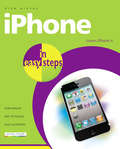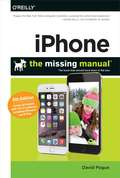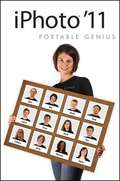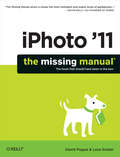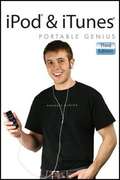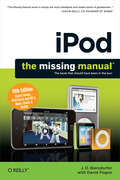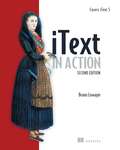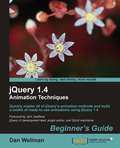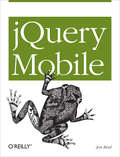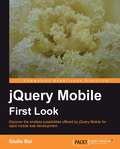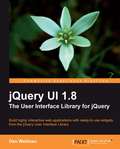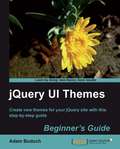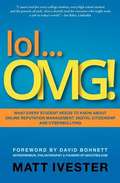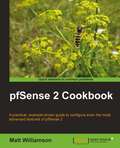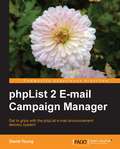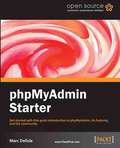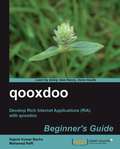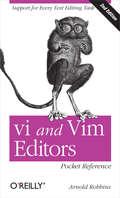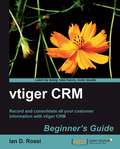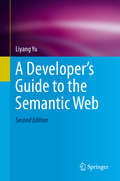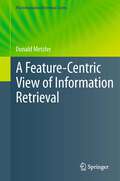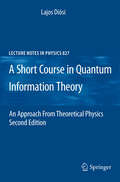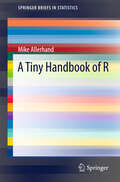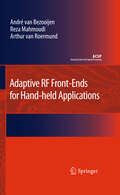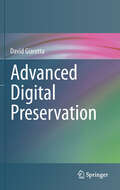- Table View
- List View
iPhone in Easy Steps: Covers iPhone 4
by Dr Drew ProvanAssuming no prior knowledge and in the usual easy-to-follow In Easy Steps style, this title will start by explaining what exactly is the iPhone?Then, the author covers 136 topics which include cellular, wireless, battery and storage capabilities; Touch screen display; Virtual keyboard; audio and video playback; camera: stills and video; Buttons and controls; SIM card slot; Ports; Headphone socket; Installed programs; key new features with iPhone software version 4.0; customizing the Wallpaper; basic care of the iPhone; synchronizing data; using MobileMe; battery care; installing system software updates; initial setup and registration; Networks: Edge, 3G and WiFi; Airplane mode; all the clever ways of making phone calls including conference calls; music video; communicating using other programs including skype... everything the reader needs to know to make the most of the iPhone.All this for less than $15! A worthwhile investment for any iPhone 4 newbie!
iPhone: The Missing Manual
by David PogueWith the iOS5 software and the new iPhone 4S device, Apple has another world-class hit on its hands. This sleek, highly refined pocket computer comes with everything--cellphone, iPod, Internet, camcorder--except a printed manual. Fortunately, David Pogue is back with the latest edition of his witty, crystal-clear, colorful guide: the world's most popular iPhone book. Use it as a phone. Learn the basics as well as time-saving tricks and tips for contact searching by voice, texting, and more. Manage your stuff in the cloud. Sync and back up your contacts and media across all of your devices with iCloud. Get things done. Ask Siri to send reminders, place calls, and more. Master notifications. Use the Notification Center to find missed messages, calendar invitations, friend requests, and more. Connect with other iPhone owners. Send unlimited iMessages to friends, family, and colleagues who are also running iOS5. Treat it as an iPod. Master the ins and outs of iTunes, and listen to music, upload and view photos, and fill the iPhone with TV shows and movies. Take the iPhone online. Make the most of your online experience to browse the Web, read and compose email, use social networks, or send photos and audio files. Go beyond the iPhone. Learn how to use the App Store, and how to multitask between your apps, organize them in folders, and read ebooks in iBooks. Whether you have a brand-new iPhone or want to update an earlier model with the iOS5 software, this beautiful full-color book is the best, most objective resource available.
iPhoto '11 Portable Genius
by Brad MiserWhat serious fans need to take full advantage of iPhoto Part of the incredibly popular iLife suite that comes loaded on every Mac, iPhoto is the standard for digital photo management and editing programs. This smart and clever guide gives iPhoto users the inside track on the key skills, tools and shortcuts to accomplish every task iPhoto can do, including some hidden gems that most users miss. It helps maximize the key features of the newest version so Mac users can get the most from their systems. iPhoto is part of the iLife digital lifestyle suite that is pre-installed on every new Mac; this guide helps Mac users take full advantage of its features Packed with facts, secrets, tips, and techniques to help you manage and edit your digital photos more effectively Includes key information that can save you time and hassle and uncovers facts you might not discover just by using the software Authoritative but down-to-earth, this small book is big on expert advice that helps you discover and make the most of every feature of iPhoto.
iPhoto '11: The Missing Manual (The\missing Manual Ser.)
by David Pogue Lesa SniderWith better ways to get your photos online and new options for creating printed projects, iPhoto '11 makes it easier than ever to transfer photos from a digital camera, organize them, and publish, print, or share them in maps--but there's still no printed manual for the program. Fortunately, David Pogue and Lesa Snider team up in this witty, authoritative book that should have been in the box. Organize your collection. Discover all of the options for grouping your pictures--by events, in albums, or based on who's in the photo or where it was taken. Sharpen your editing skills. Learn how to use iPhoto's beefed-up editing options, including its Photoshop-like adjustments panel. Share images online. Get your photos to everyone on your list by publishing them to Flickr, Facebook, and MobileMe. Dive into creative projects. Have fun building slideshows (with music), gift books, calendars, and cards.
iPod and iTunes Portable Genius
by Jesse D. HollingtonGet the most from iTunes and your iPod with these hip tipsApple's iPod revolutionized the way we enjoy music. This no-nonsense guide is packed with advice and ideas to help you get everything that amazing piece of technology can offer. Learn the most efficient way to create playlists, manage your photos, find exactly what you want at the iTunes Store, download music and movies, and make your iPod as individual as you are with the expert advice in this little book.The iPod has dozens of features that most casual users miss; this book is the key to taking full advantage of your iPod and using iTunes more efficientlyLoaded with tips and techniques that help you do more with your iPod; gets right to the point without wasting time on things you already knowFeatures special icons to highlight innovative techniques and ways to save time and hassleCompact and full-color, iPod & iTunes Portable Genius helps you get the most from your iPod and iTunes.
iPod: The Missing Manual, Tenth Edition
by J. D. Biersdorfer<p>Get the complete scoop the latest line of iPods and the most recent version of iTunes with the guide that outshines them all—<i>iPod: The Missing Manual</i>. Teeming with high-quality color graphics, this books helps you manage your media, play back music, videos, and photo slideshows, and keep your calendars and contacts up-to-date. Whether you have a brand-new iPod or an old favorite, this book provides expert guidance on all the amazing things you can do.</p>
iText in Action
by Bruno LowagieWith iText, one can transform PDF documents into live, interactive applications quickly and easily. This free and open source library for Java and .NET is the leading tool of its kind, and was primarily developed and maintained by Bruno Lowagie, the author of this book.iText in Action, Second Edition offers an introduction and a practical guide to iText and the internals of PDF. While at the entry level iText is easy to learn, there's an astonishing range of things you can do once you dive below the surface. This book lowers the learning curve and, through numerous innovative and practical examples, unlocks the secrets hidden in Adobe's PDF Reference.This totally revised new edition introduces the new functionality added to iText in recent releases, and it updates all examples from JDK 1.4 to Java 5. The examples are in Java but they can be easily adapted to.NET. Purchase of the print book comes with an offer of a free PDF, ePub, and Kindle eBook from Manning. Also available is all code from the book.
jQuery 1.4 Animation Techniques: Beginners Guide
by Dan WellmanAll the concepts in the book are explained in a simple, easy to understand, step-by-step manner. There are plenty of examples and images used in this book, with the images properly explained. Written with a friendly and engaging approach, this Packt Beginner's guide is designed to be placed alongside the computer as your guide and mentor to create attractive web page animations using jQuery.This book is written for web designers and front-end developers who already have good knowledge of HTML and CSS, and some experience with jQuery. If you want to learn how to animate the user interface of your web applications with jQuery, then this book is for you.
jQuery Mobile
by Jon ReidNative apps have distinct advantages, but the future belongs to mobile web apps that function on a broad range of smartphones and tablets. Get started with jQuery Mobile, the touch-optimized framework for creating apps that look and behave consistently across many devices. This concise book provides HTML5, CSS3, and JavaScript code examples, screen shots, and step-by-step guidance to help you build a complete working app with jQuery Mobile.If you're already familiar with the jQuery JavaScript library, you can use your existing skills to build cross-platform mobile web apps right now. This book shows you how.Get a high-level overview of jQuery Mobile: how it works and how to use itLearn about paging and navigation, including dialogs, Ajax content, and historyEmploy jQuery Mobile’s extensive event system to create rich interactionsWork with toolbars, buttons, lists, forms, and other UI elementsCreate a variety of visual designs with jQuery Mobile’s sophisticated theming systemUse the jQuery Mobile API for finer control over elements and interactionsPut everything together and build a mobile app from start to finish
jQuery Mobile First Look
by Giulio BaiThe jQuery Mobile First Look is a perfect reference to keep on your desk for finding out the capabilities of the jQuery Mobile framework and how you can put it to good use. This book will show you how to enjoy your programming by letting a simple yet effective JavaScript library handle the hassles you would encounter otherwise. It will quickly take you through the entire framework and cover every level of specification you need to know to kick-start your mobile web development.This is a First Look book that allows existing jQuery users to get a look at the features of jQuery mobile. It is targeted at jQuery users who want to enter the exciting world of mobile web development. All you need is the basics of jQuery and an interest to get involved with mobile development and you can use this book as a launch-pad for your future ventures in mobile web development with jQuery Mobile framework.
jQuery UI 1.8: The User Interface Library for jQuery
by Dan WellmanAn example-based approach leads you step-by-step through the implementation and customization of each library component and its associated resources. Reference tables of each configuration option, method, and event for each component are provided, alongside detailed explanations of how each widget is used. This book is for front-end designers and developers who need to quickly learn how to use jQuery UI. To get the most out of this book you should have a good working knowledge of HTML, CSS, and JavaScript, and should ideally be comfortable using jQuery.
jQuery UI Themes Beginner's Guide
by Adam BoduchThis book is a step-by-step tutorial aimed at beginners to JQuery UI Themes. There is ready-for-use sample code explained with essential screenshots for better and quicker understanding.This book is for web application developers and CSS designers who want a better understanding of how to build themes for the jQuery UI toolkit. The reader should have a basic working knowledge of JavaScript and why it is used in web applications. Experience with jQuery UI and a general working knowledge of CSS will speed things along but aren't a requirement. Readers can use this book as a starting point to familiarize themselves with the jQuery UI widget details.
lol... Omg! What Every Student Needs to Know about Online Reputation Management, Digital Citizenship and Cyberbullying
by Matt IvesterThe ease with which digital content can be shared online, in addition to its many benefits, has created a host of problems for today's high school and college students. All too often, students are uploading, updating, posting and publishing without giving a second thought to who might see their content or how it might be perceived. lol. . . OMG! provides a cautionary look at the many ways that today's students are experiencing the unanticipated negative consequences of their digital decisions - from lost job opportunities and denied college and graduate school admissions to full-blown national scandals. It also examines how technology is allowing students to bully one another in new and disturbing ways, and why students are often crueler online than in person. By using real-life case studies and offering actionable strategies and best practices, this book empowers students to clean up and maintain a positive online presence, and to become responsible digital citizens.
pfSense 2 Cookbook
by Matt WilliamsonThis book is written in a cookbook style. Each chapter consists of recipes, each of which is composed of step-by-step instructions to complete a particular task. Each recipe also includes tips, alternatives, and references to other recipes or appropriate external sources. The book can be explored chapter by chapter or in no particular order.This book is intended for all levels of network administrators. If you are an advanced user of pfSense, then you can flip to a particular recipe and quickly accomplish the task at hand, while if you are new to pfSense, you can read chapter by chapter and learn all of the features of the system from the ground up.
phpList 2 E-mail Campaign Manager
by David YoungThis is a step-by-step comprehensive tutorial with plenty of screenshots for easier and quicker learning and real-world examples for good pickup.This book is aimed at content creators and distributors who want to up their game to a full e-mail distribution engine.Further, it will certainly appeal to you if you are technically inclined and would rather roll your own system than use an off-the-shelf product.You are assumed to be familiar with the basic concepts of e-mail, editing text files, and managing remote files with FTP / SFTP.Advanced topics will teach you to get your hands dirty in some of phpList's open-source code.
phpMyAdminStarter
by Marc DelisleIf you are new to phpMyAdmin this e-book is the perfect companion for getting you off to a flying start. No previous experience with phpMyAdmin is required as you will be guided through downloading phpMyAdmin and installing it on your system. The amount of things that you can do with phpMyAdmin is overwhelming so the quick start guide will show you how to create your very first tables. The list of resources in this e-book will help you to become familiar with the phpMyAdmin community, which is a valuable part of any Open Source project. Finally, you will see how to use five key features of phpMyAdmin - including browsing, searching, and changing data, exporting to Excel, and creating relations - which will allow you to perform simple tasks to learn the basics and set off on your own.
qooxdoo Beginner's Guide
by Rajesh Kumar Bachu Mohamed RaffiThis is a Packt beginner's guide. The unique style of the book is to set the requirements for an application, Team Twitter, in the first chapter and apply the concepts in the application as you learn in the following chapters. When you complete this book, you would have developed a complete application. Although the scope of this book is only on the Qooxdoo framework, which is a client side framework, we have explained how to set up one of the RPC servers and demonstrated the end to end application in the Team Twitter. This book is intended for the client side developers who design and develop internet web applications and enterprise web applications. If you want to start developing RIA applications in Qooxdoo, this book would be a great help to jump start your development. If you are already developing Qooxdoo applications, this book will help you to go through the Qooxdoo framework quickly to improve your contribution to your project. This book is also intended for the desktop application developers who want to move into RIA development and develop internet web applications and rich enterprise web applications. It also provides an idea for the Architects and Lead developers to know about Qooxdoo and evaluate the framework. It helps beginners in Qooxdoo to easily set up the development environment and explains the concepts in an order that is easily graspable by beginners.
vi and Vim Editors Pocket Reference: Support for every text editing task
by Arnold RobbinsMany Unix, Linux, and Mac OS X geeks enjoy using the powerful, platform-agnostic text editors vi and Vim, but there are far too many commands for anyone to remember. Author Arnold Robbins has chosen the most valuable commands for vi, Vim, and vi's main clonesâ??vile, elvis, and nviâ??and packed them into this easy-to-browse pocket reference. You'll find commands for all kinds of editing tasks, such as programming, modifying system files, and writing and marking up articles.This second edition includes:Command-line optionsvi commands and set optionsInput mode shortcutsSubstitution and regular expressionsex commands and optionsInitialization and recoveryEnhanced tags and tag stacksA greatly expanded section on Vim commands and optionsAdditional features in vile, elvis, and nviInternet resources for viA full index
vtiger CRM Beginner's Guide
by Ian D. RossiThis book covers the basics of installing and using a CRM system, explaining how to implement vtiger's powerful features for your business, adding extensions, plug-ins, and theming. It provides a step-by-step guide to installing, configuring, and customizing vtiger even at the code level, with practical advice and directions. This is book is written for IT professionals and business managers who have power-user computer skills and are looking to improve sales management processes and/or customer service processes.
A Developer’s Guide to the Semantic Web
by Liyang YuCovering the theory, technical components and applications of the Semantic Web, this book's unrivalled coverage includes the latest on W3C standards such as OWL 2, and discusses new projects such as DBpedia. It also shows how to put theory into practice.
A Feature-Centric View of Information Retrieval (The Information Retrieval Series #27)
by Donald MetzlerCommercial Web search engines such as Google, Yahoo, and Bing are used every day by millions of people across the globe. With their ever-growing refinement and usage, it has become increasingly difficult for academic researchers to keep up with the collection sizes and other critical research issues related to Web search, which has created a divide between the information retrieval research being done within academia and industry. Such large collections pose a new set of challenges for information retrieval researchers. In this work, Metzler describes highly effective information retrieval models for both smaller, classical data sets, and larger Web collections. In a shift away from heuristic, hand-tuned ranking functions and complex probabilistic models, he presents feature-based retrieval models. The Markov random field model he details goes beyond the traditional yet ill-suited bag of words assumption in two ways. First, the model can easily exploit various types of dependencies that exist between query terms, eliminating the term independence assumption that often accompanies bag of words models. Second, arbitrary textual or non-textual features can be used within the model. As he shows, combining term dependencies and arbitrary features results in a very robust, powerful retrieval model. In addition, he describes several extensions, such as an automatic feature selection algorithm and a query expansion framework. The resulting model and extensions provide a flexible framework for highly effective retrieval across a wide range of tasks and data sets. A Feature-Centric View of Information Retrieval provides graduate students, as well as academic and industrial researchers in the fields of information retrieval and Web search with a modern perspective on information retrieval modeling and Web searches.
A Short Course in Quantum Information Theory: An Approach From Theoretical Physics (Lecture Notes in Physics #827)
by Lajos DiosiThis short and concise primer takes the vantage point of theoretical physics and the unity of physics. It sets out to strip the burgeoning field of quantum information science to its basics by linking it to universal concepts in physics. An extensive lecture rather than a comprehensive textbook, this volume is based on courses delivered over several years to advanced undergraduate and beginning graduate students, but essentially it addresses anyone with a working knowledge of basic quantum physics. Readers will find these lectures a most adequate entry point for theoretical studies in this field. For the second edition, the authors has succeeded in adding many new topics while sticking to the conciseness of the overall approach. A new chapter on qubit thermodynamics has been added, while new sections and subsections have been incorporated in various chapter to deal with weak and time-continuous measurements, period-finding quantum algorithms and quantum error corrections. From the reviews of the first edition: "The best things about this book are its brevity and clarity. In around 100 pages it provides a tutorial introduction to quantum information theory, including problems and solutions. ... it's worth a look if you want to quickly get up to speed with the language and central concepts of quantum information theory, including the background classical information theory." (Craig Savage, Australian Physics, Vol. 44 (2), 2007)
A Tiny Handbook of R (SpringerBriefs in Statistics)
by Mike AllerhandThis Brief provides a roadmap for the R language and programming environment with signposts to further resources and documentation.
Adaptive RF Front-Ends for Hand-held Applications (Analog Circuits and Signal Processing)
by Reza Mahmoudi Arthur H.M. van Roermund Andre Van BezooijenThe RF front-end - antenna combination is a vital part of a mobile phone because its performance is very relevant to the link quality between hand-set and cellular network base-stations. The RF front-end performance suffers from changes in operating environment, like hand-effects, that are often unpredictable. Adaptive RF Front-Ends for Hand-Held Applications presents an analysis on the impact of fluctuating environmental parameters. In order to overcome undesired behavior two different adaptive control methods are treated that make RF frond-ends more resilient: adaptive impedance control, and adaptive power control. Several adaptive impedance control techniques are discussed, using a priori knowledge on matching network properties, in order to simplify robust 2-dimensional control. A generic protection concept is presented, based on adaptive power control, which improves the ruggedness of a power amplifier or preserves its linearity under extremes. It comprises over-voltage, over-temperature, and under-voltage protection.
Advanced Digital Preservation
by David GiarettaThere is growing recognition of the need to address the fragility of digital information, on which our society heavily depends for smooth operation in all aspects of daily life. This has been discussed in many books and articles on digital preservation, so why is there a need for yet one more? Because, for the most part, those other publications focus on documents, images and webpages - objects that are normally rendered to be simply displayed by software to a human viewer. Yet there are clearly many more types of digital objects that may need to be preserved, such as databases, scientific data and software itself. David Giaretta, Director of the Alliance for Permanent Access, and his contributors explain why the tools and techniques used for preserving rendered objects are inadequate for all these other types of digital objects, and they provide the concepts, techniques and tools that are needed. The book is structured in three parts. The first part is on theory, i.e., the concepts and techniques that are essential for preserving digitally encoded information. The second part then shows practice, i.e., the use and validation of these tools and techniques. Finally, the third part concludes by addressing how to judge whether money is being well spent, in terms of effectiveness and cost sharing. Various examples of digital objects from many sources are used to explain the tools and techniques presented. The presentation style mainly aims at practitioners in libraries, archives and industry who are either directly responsible for preservation or who need to prepare for audits of their archives. Researchers in digital preservation and developers of preservation tools and techniques will also find valuable practical information here. Researchers creating digitally encoded information of all kinds will also need to be aware of these topics so that they can help to ensure that their data is usable and can be valued by others now and in the future. To further assist the reader, the book is supported by many hours of videos and presentations from the CASPAR project and by a set of open source software.
